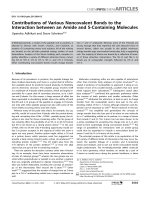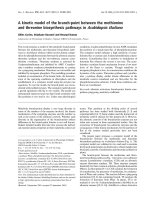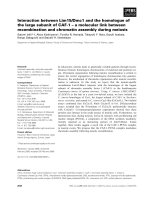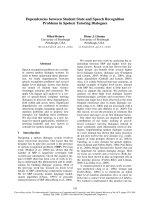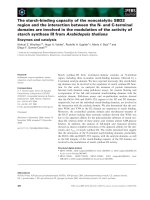Interaction between local people and natural forest resources in dai dinh commune tam dao district vinh phuc province
Bạn đang xem bản rút gọn của tài liệu. Xem và tải ngay bản đầy đủ của tài liệu tại đây (885.45 KB, 60 trang )
MINISTRY OF AGRICULTURE AND RURAL DEVELOPMENT
VIETNAM NATIONAL UNIVERSITY OF FORESTRY
***
STUDENT THESIS
INTERACTION BETWEEN LOCAL PEOPLE AND NATURAL FOREST
RESOURCES IN DAI DINH COMMUNE, TAM DAO DISTRICT, VINH PHUC
PROVINCE
Major: Natural Resources Management
Code: D850101
Faculty: Forest Resources and Environmental Management
Student: Nguyen Minh Chau
Student ID: 1453091265
Class: K59A Natural Resources Management
Course: 2014 - 2018
Advanced Education Program
Developed in collaboration with Colorado State University, USA
Supervisor: Asso.,Prof., Dr. Do Anh Tuan
Hanoi, 2018
ACKNOWLEDGEMENT
First of all, I would like to express the profound gratitude to Assoc. Prof. Do Anh Tuan,
my advisor, for his academic guidance, advice, and encouragement throughout the study.
Many thanks are also given to:
Leaders and staffs of the Department of Agriculture and Rural Development in Vinh Phuc
province as well as People's Committee of Dai Dinh commune for their supports and
dedicated help in during I conduct this thesis and in the field.
Lastly, I would like to thanks my family: my mother always support to me and my friends
who helped me in my research.
i
TABLE OF CONTENDS
ACKNOWLEDGEMENT ........................................................................................................ i
TABLE OF CONTENDS ......................................................................................................... ii
LIST OF TABLES ................................................................................................................... iv
LIST OF FIGURES .................................................................................................................. v
CHAPTER I. INTRODUCTION ............................................................................................ 1
CHAPTER II. LITERATURE REVIEW .............................................................................. 3
2.1. Buffer zone management ........................................................................................... 3
2.2. Buffer zone and livelihood development in Vietnam ................................................. 6
CHAPTER III. STUDY SITE AND SOCIO-ECONOMIC FEATURES ........................... 9
3.1. Study Site................................................................................................................... 9
3.2. Natural features ....................................................................................................... 11
3.2.1. Topographical conditions ............................................................................................... 11
3.2.2. Land ................................................................................................................................ 11
3.2.3. Climate and hydrology ................................................................................................... 12
3.3. Socio-economic features ........................................................................................... 13
CHAPTER IV. GOAL, OBJECTIVES AND METHODS ................................................. 16
4.1. Goal ......................................................................................................................... 16
4.2. Objectives ................................................................................................................ 16
4.3 Methodology ............................................................................................................. 16
4.3.1. Secondary data collection ............................................................................................... 16
4.3.2. Household interviews ..................................................................................................... 16
4.3.3. Key information interview ............................................................................................. 17
4.3.4. Analysis data method ..................................................................................................... 18
CHAPTER V. RESULTS AND DISCUSSIONS ................................................................. 19
ii
5.1. Characteristics of the natural forest resources in Dai Dinh commune ..................... 19
5.1.1. The area and distribution of natural forest resources ..................................................... 19
5.1.2. Forest land status in Dai Dinh commune, Tam Dao district, Vinh Phuc province. ....... 20
5.1.3: Area of forest and forest land by administrative unit in Dai Dinh commune, Tam Dao
district, Vinh Phuc province. .................................................................................................... 21
5.1.4. Plant species composition............................................................................................... 23
5.1.5. Forest cover .................................................................................................................... 24
5.2. Socio-economic characteristics of the sampled households in Dai Dinh commne .... 25
5.2.1. Population, ethnic composition, education and occupation ........................................... 25
5.2.2. Economic conditions of sample households ................................................................... 27
5.3. Forest resources and forest land uses of local people and their dependency on forest
resources. ....................................................................................................................... 28
5.3.1. Forest resources and forest land use activities of local communities ............................. 28
5.3.2. Dependency of Local people on the Forest Resources ................................................... 33
5.4. Recommendations for natural forest resources management in Dai Dinh commune35
5.4.1. Integrated agroforestry model. ....................................................................................... 35
5.4.2. Creating sustainable livelihood for local people ............................................................ 36
CHAPTER VI. CONCLUSIONS AND RECOMMENDATIONS .................................... 38
6.1 Conclusions............................................................................................................... 38
6.2. Recommendations.................................................................................................... 38
REFERENCES
Appendix
iii
LIST OF TABLES
Table 3. 1: Classification of land by elevation and slope of Dai Dinh commune .................... 11
Table 3. 2: Land use in Dai Dinh commune ............................................................................. 12
Table 3. 3: Population and labor in Dai Dinh Commune ......................................................... 14
Table 4. 1: Sample size of Selected Sample Households ......................................................... 17
Table 5. 1: The area of forest in Dai Dinh commune ............................................................... 19
Table 5. 2: The forest land status in Dai Dinh commune ......................................................... 21
Table 5. 3: Area of forest land types by the administrative unit in Dai Dinh commune .......... 22
Table 5. 4: List of composition of vascular plants of Tam Dao national park in Dai Dinh
commune .................................................................................................................................. 23
Table 5. 5: List of thirteen families has the largest number of Tam Dao National Park in Dai
Dinh commune ......................................................................................................................... 24
Table 5. 6: Distribution of population aged 6 years and above by level of literacy and sex .... 26
Table 5. 7: Percentage distribution of population aged 18 years and above by main jobs of
sample households .................................................................................................................... 27
Table 5. 8: Welfare ranking of sample household in Dai Dinh ................................................ 28
Table 5. 9: List of the medicinal plants in sample households ................................................. 30
Table 5. 10: Sample household income from collecting medicinal plants ............................... 31
Table 5. 11: Forest resources use activities in Dai Dinh commune ......................................... 32
Table 5. 12: Average total income and average income from natural forest resources of group
household per month in Dai Dinh commune ............................................................................ 33
Table 5. 13: Household income from forest resources use in period of 2013 – 2018 .............. 34
iv
LIST OF FIGURES
Figure 3. 1: Map of study area .................................................................................................. 10
Figure 5. 1: Distribution of natural forest resources in Dai Dinh commune ............................ 20
Figure 5. 2: Type of forest by origin ........................................................................................ 22
Figure 5. 3: Type of forest by purpose of using forest ............................................................. 22
Figure 5. 4: Forest cover at Dai Dinh commune in 2005 - 2017 .............................................. 25
Figure 5. 5: The results of welfare ranking of sample household in Dai Dinh ........................ 28
Figure 5. 6: The results of sample household income from collecting medicinal plants in Dai
Dinh commune ......................................................................................................................... 31
Figure 5. 7: Frequency of visit of sample households to harvest the forest products .............. 33
Figure 5. 8: Percentage of average total income and average income from natural forest
resources of group household per month in Dai Dinh commune ............................................. 34
Figure 5. 9: Percentage of household income from forest resources use in period of 2013 –
2018 .......................................................................................................................................... 35
v
CHAPTER I. INTRODUCTION
It has long been a matter of preserving biodiversity, the quality of ecosystems and the
landscapes, rich fauna and flora of many national parks degraded by the pressure of the
people living outside. Therefore, national parks have been of interest. More importantly, the
construction of a buffer zone, creating an additional protection belt for the national park to
exclude outside influences has been set in many countries around the world, including
Vietnam. In Vietnam, many national parks and protected areas have been built, but most of
them are often intermingled with residential areas and under heavy pressure from the outside.
The buffer zone is designed to address these constraints, to improve the living standard of
local communities such as creating more jobs so that they can relieve pressure on
conservation and education, encourage them to actively participate in conservation.
Tam Dao National park is a protected area zone of Vietnam, located in the Tam Dao
mountain range, a large mountain range over 80 km long, 10 - 15 km wide, along with the
direction of Northwest - Southeast. The national park spreads over 3 provinces of Vinh Phuc,
Thai Nguyen and Tuyen Quang, about 75 km north to Hanoi. Tam Dao National Park has an
area of 34,995 ha, geographic coordinates 21 ° 21' - 21 ° 42 ' North latitude, 105 ° 23' - 105 °
44' East longitude. The national park has currently 26,163 ha of forest, which is mainly
natural forest, covering over 70% of the total area. Tam Dao National park has 1,282 plant
species belonging to 660 genera of 179 vascular plant families, including sub-tropical species.
There are 42 endemic species and 64 rare species. Moreover, the national park also has 163
animal species belonging to 158 families of 39 orders. There are 239 species of birds, 64
species of mammal with valuable specie, 39 endemic species. Natural resources in Tam Dao
National Park play a vital role in ensuring ecosystem balance and biodiversity conservation.
In addition, natural resources are main materials for economic development. Local people
1
depend on forests, cultivating and exploiting natural resources to sustain and develop the
economy.
Tam Dao National Park is considered to be highly diverse. However, due to pressure of
population, management is still difficult. Hunting and cutting plants are main reasons causing
the loss of species in the National park. In addition, the development of tourism has ruined the
natural beauty and environmental degradation of Tam Dao National park. To solve this
problem, the buffer zone was created. That helps review interaction of Tam Dao National
Park development to the creation of sustainable livelihoods for the people living in the buffer
zone which is of importance, in terms of total the results are not only to assess the role but
also to draw lessons in creating sustainable livelihoods for the people. This will provide more
effective management approaches of Tam Dao National Park and buffer zones in the future.
In Tam Dao district, Vinh Phuc province, there are seven communes belonging to buffer zone
(Tam Dao town and 6 communes including Dao Tru, Dai Dinh, Tam Quan, Ho Son, Hop
Chau and Minh Quang).
Dai Dinh is a mountainous commune located in the buffer zone of Tam Dao district. Due
to the geographical conditions of the hills and mountains, the livelihoods of people in Dai
Dinh commune depend mainly on forests and forest land which can provide people with food,
medicinal plants, firewood, water and livestock grazing areas and so on. Determining the
relationship between local people and natural forest resources is important, therefore, I chose
the topic about: “INTERACTION BETWEEN LOCAL PEOPLE AND NATURAL FOREST
RESOURCES IN DAI DINH COMMUNE, TAM DAO DISTRICT, VINH PHUC
PROVINCE” with the purpose of evaluating the interaction of people with the buffer zone
and proposing recommendations for sustainable forest management and livelihood
development of local people.
2
CHAPTER II. LITERATURE REVIEW
2.1. Buffer zone management
Buffer zones are created to enhance the protection of a specific conservation area, often
peripheral to it. According to IUCN (1999) “Buffer zones are clearly demarcated, forested or
non-forested areas that are outside the boundary of the nature reserve and managed to enhance
the conservation of the nature reserve and buffer zone, and it bring many benefits to people
living around the nature reserve ". Within the buffer zones, resources used may be legally or
customarily restricted, often to a lesser degree than in the adjacent protected area so as to form
a transition zone. A buffer zone can also be designated as a protected area and be assigned an
IUCN Management Categories depending on the conservation objectives.
The technique of surrounding a protected area with other protected and non-protected areas
allows for the creation of a gradient of protection around the core site. Buffer zones are
therefore an important part of conservation strategies for a wide variety of sites of biodiversity
importance, in particular, for World Heritage sites and Man and the Biosphere Reserves.
Furthermore, buffer zones have been suggested as a particularly suitable practice for climate
change mitigation, as they may facilitate the shifting of populations from reserves to adjacent
lands according to the climatic needs of species. The term "buffer zone" gained international
prominence through UNESCO’s Man and the Biosphere Programmer in 1971. UNESCO’s
Man and the Biosphere Reserves were often designed in concentric zones, with a central core
area surrounded by a buffer zone and then by a transition zone. Several buffer zone
definitions have been proposed emphasizing either conservation or both conservation and
development objectives. One of the most commonly cited definitions of buffer zones is: “an
area peripheral to a national park or equivalent reserve, where restrictions are placed upon
resource use or special development measures are undertaken to enhance the conservation
values of the area”.
3
A variety of spatial patterns and arrangements for buffer zones exist, all following the
principles, but applied under completely different conditions (ecological, political, economic,
and so on). Hence, a wide diversity can be observed in the criteria for their creation and
management. There are five aspects commonly considered in their creation.
-
Size: determined based on factors such as the objectives for creation of buffer zone,
availability of land, traditional land use systems, threats and opportunities.
-
Ecology: buffer zones vary depending on their focus on the landscape, habitat and/or
species conservation, each of which demands a different approach for their creation.
-
Economy: this involves appraisals such as cost-benefit analysis, time frame and discount
rate, to assess economic viability of establishing a buffer zone.
-
Legislation: several international treaties and conventions (e.g. Convention on Biological
Diversity, World Heritage Convention) and national level guidelines for protected areas
(e.g. Nepal) recommend creation of buffer zones.
-
Social and institutional: creation of buffer zones also involves consideration of issues
such as traditional rights of local communities, type of development activities to
minimize negative impacts of conservation, local organizations to manage buffer zones
and land tenure.
There are various approaches in buffer zone management depending on the type and
objectives of the conservation area for which they are created. For instance, activities in the
buffer zones around some protected areas or World Heritage sites are recommended to be
regulated so as to protect the core zone. In UNESCO Man and the Biosphere Reserves, socioeconomic development of local communities plays a crucial role. A buffer zone can also be
managed as an area for research to develop approaches for sustainable use of resources, for
ecosystem restoration, education and training, as well as carefully designed tourism and
recreation activities. The degree of legal protection to buffer zone varies significantly. In
most of cases where the buffer zones are outside the protected area, they fall under the
4
institutional control and jurisdiction of authorities other than those responsible for
management of the protected area.
The buffer zone was created to enhance the protection of a protected area. When buffer
zones are designated as protected areas, they will be legally protected in their own right.
When buffer zones are not also protected areas, they may not have any legal protection,
although this varies with the objective for which they were established. A few countries (e.g.
Nepal, Ghana) have developed policies and legal instruments facilitating development and
implementation of buffer zone approaches. The World Heritage Convention requires that any
modification in the buffer zone area, subsequent to inscription of a property on the World
Heritage List, should be approved by the World Heritage Committee. Moreover, buffer zones
may not be sites of active biodiversity conservation, but their establishment provides an
additional layer of protection to existing areas of biodiversity importance, and they are often
fundamental to achieve conservation of those areas. About socio-cultural values, buffer zones
can be important areas for traditional practices, cultural values, rights and involvement of
local/indigenous communities in protection, use and management around protected areas. For
example, among different approaches of buffer zone creation, social buffer zones use the
culture and sense of identity of indigenous or other population groups, and local
organizations, to form a barrier, control and monitoring system between a conservation area
and its surroundings.
In Venezuela (Paraiso National Park) and Niger (Air-Tenere Nature Reserve) the National
Committee has proposed community development programs in the buffer zone, such as
education development, using new farming practices for local communities and developing
new economic activities to enhance the buffer zone as well as reducing the impact of local
people on the core zone.
Natural forest resources are closely related to local community life. According to a report
by the United Nations Food and Agriculture Organization, forests provide wood and energy
5
to humans. The value of wood products traded on the world market annually amounts to $
36,000 million. The world consumption of firewood and charcoal is up to 1,800 million m³.
In addition, the forest provides non-timber products including food, herbs, plastics, fibers,
animal feed and other essential products.
2.2. Buffer zone and livelihood development in Vietnam
In Vietnam, forests and forestland occupy three-fourths of Vietnam's natural area, which is
home to more than two thirds of the country's population and 75% of the country's population
depends on agriculture and forests as vital livelihood. Increasing population causes great
pressure on forest resources.
Vietnam established its first National Park, Cuc Phuong, in 1962. Since then a total of 11
National
Parks,
52
Nature
Reserves,
16
Wildlife
Protection
Sites
and
22
Historic/Culture/Environment Sites have been established, covering a total area of
approximate 2.3 million ha. Many of these reserves were established over village lands where
people were living. In some cases, people were moved from within the reserve boundary to
the periphery. After 1975, new economic zones were established throughout the country, and
many of these are on the margins of protected areas. Many new settlers were brought to these
zones, thus increasing substantially the existing populations. In virtually all cases, dense
populations of people are living on the margins of the reserves. Most local people see
protected areas something imposed by the government and brings them little if any benefits.
Many, either by tradition or through economic necessity, use various wood and non-wood
resources from the reserves for both subsistence and market benefits, with the result that most
reserves are continuing to degrade, sometimes very rapidly. The government has found that
legal protection is insufficient to guarantee actual protection, and even fairly strong
enforcement has relatively little effect. Consequently, there has been growing interest in
Vietnam in using buffer zones on the periphery of protected areas to take the pressure off their
sources inside the reserves. Several donor-supported buffer zone projects have been gaining
6
valuable experience during the past few years, and several larger projects are in an advanced
planning stage. Particularly, project 327, a major program to support forest development,
began in 1992. These projects support activities related to planting on open land, coastal
sandy land and in special-use forests, protection forests and production forests. The goal is to
reduce poverty and support resettlement, and support is also provided to promote livestock,
cash crops and industrial crops. Besides, the investment project with grants is also a project to
support the buffer zone. In particular, international investment in protected areas is a larger
buffer zone investment than investment in the core zone. For example, the project was
invested by the EU in Pu Mat Nature Reserve is 17.5 million Euros (23 million USD), of
which the investment in the buffer zone is 16.4 million Euros, the investment for the core
zone is 1.1 million Euros.
According to D.A. Gilmour and Nguyen Van San (1999) most of the buffer zones are
populated, such as Ba Vi National Park (42,000 people), Bach Ma National Park (62,000
people), Cat Tien National Park (162000 people), Cuc Phuong National Park (50000 people).
Therefore, there are many difficulties in management. As mentioned above, it is now widely
recognized that buffer zones are areas of land immediately outside the boundary of protected
areas. In all three of the case studies National Park staff and District and Commune officials
acknowledged the existence of a buffer zone. In some cases, the boundary was coincident
with the boundary of the communes adjacent to the national park, while in other cases the
boundary bisected the commune and followed roads. This was claimed by commune officials
to have created some difficulties in providing equity in the allocation of development
activities from different sources. At Cat Tien, the boundary of the National Park has been
redefined on paper, but there was confusion among some residents about whether they lived
inside or outside the national park. This uncertainty prevented the allocation of red books and
prevented farmers obtaining bank loans for agricultural development. The boundary of the
Park at Ba Vi is defined as the 100 m contour interval. This makes a clear definition on the
7
ground rather difficult, and consequently complicates management. State Forest Enterprises
occupy land on the boundary of most of the Parks, and there is often uncertainty as to which
part of their land is considered to be in the buffer zone. At Bach Ma, some of the State Forest
Enterprises are considered to be wholly within the buffer zone, while the buffer zone
boundary bisects others.
In Vietnam, forests play an important role for local people. In addition to supplying forest
land, it also provides them with energy, food, medicine as well as building materials or
housewares. Natural forest resources make a significant contribution to people's incomes, it
helps them to become richer by providing source of products and materials, adding inputs to
agriculture and preserving biomass. In general, people depend on natural forest resources for
two main aspects. The first is income dependency, which is related to total income and
income from the sale of forest products. The second is livelihood dependency, which is the
kind of forest products used daily. Thus, natural forest resources are one of the income
sources and livelihoods of local people in mountainous areas
8
CHAPTER III. STUDY SITE AND SOCIO-ECONOMIC FEATURES
3.1. Study Site
Dai Dinh commune is located in the northwest of Tam Dao district, Vinh Phuc province.
Dai Dinh commune in coordination of 21°27’43’’ North latitude, 105°34’57’’East longitude.
Dai Dinh commune has a total natural area of 3455.1 ha. Of which the forest area is 2244.8
ha. The commune is about 75 km northwest to Hanoi.
The East borders on core zone of Tam Dao National park.
The West borders on Dong Tinh commune, Tam Duong district.
The South borders on Hoang Hoa commune in Tam Duong district and Tam Quan
commune in Tam Dao district.
The North borders on Dao Tru commune and Bo Ly commune.
Dai Dinh Commune has many relics, especially Truc Lam - Tay Thien Monastery which
stretches in the north-west direction of Tam Dao Mountain in Dai Dinh Commune with the
height from 250 m to 3000 m above sea level. The commune has provincial road No.302
running through facilitating economic, cultural and social exchange.
9
Figure 3. 1: Map of study area
10
3.2. Natural features
3.2.1. Topographical conditions
Table 3. 1: Classification of land by elevation and slope of Dai Dinh commune
No
Height
Area
Percent
Slope
Area
Percent
above sea
(ha)
(%)
()
(ha)
(%)
755
21.85
>15
1955.7
56.60
1274.1
36.86
8 – 15
591.3
17.11
1426
41.29
<8
908.1
26.2
3455.1
100
3455.1
100
level
(m)
1
> 300m
2
100 – 300
3
<100m
Total
(Source: Department of Natural Resources and Environment of Tam Dao district, 2017)
Dai Dinh is a commune of Tam Dao district, located on the northwestern part of the Tam
Dao Range. Dai Dinh commune has complex diversified terrain because of both highland and
mountainous areas. The terrain of the commune is divided into 3 different zones. In particular,
the terrain is mainly under 100 m (1426 ha), accounting for 41.29%. Height from 100 m – 300
m are the low mountain range accounting for 36.86%, the rest is higher than 300 m.
Moreover, the terrain of Dai Dinh commune has a slope of over 15° (56.6%). The areas of Dai
Dinh commune stretches along the north-south-east direction, each area with its own natural
conditions and distinct economic resources. Especially, the hilly terrain is favorable for the
protection of natural forest resources.
3.2.2. Land
With the mountainous terrain, Dai Dinh commune has main feralit soil, which is a
favorable condition, to develop forest plantation and industrial trees.
11
Table 3. 2: Land use in Dai Dinh commune
No
Purpose of use
Area (ha)
Total natural area
Agriculture – forestry land
1
1.1
Agriculture land
1.2
Forestry land
2
Non-agricultural land
3
Unused land
Percent (%)
3455.1
100
2729.7
79.00
484.9
14.03
2244.8
64.97
725.4
21.00
0
0
(Source: Department of Natural Resources and Environment of Tam Dao district, 2017)
In the total area of 3455.1 ha of natural area in Dai Dinh commune, agricultural land
occupies 14.03% of the total natural area. The area of agricultural land in Tam Dao district is
estimated to be 484.9 ha. The forest land of the commune is 2244.8 ha, accounting for 64.97%
of the total natural area. Through the current status of land use, we see that the economic
development of the commune heavily depends on agriculture and forestry. Due to topographic
features, forest land has the highest proportion. This is a good condition for reserving and
supplying water for the activities of the commune as well as of ethnic minority people in the
high terrain areas where the irrigation system cannot provide enough water.
3.2.3. Climate and hydrology
Climate
Dai Dinh commune is located in the monsoon humid tropical climate. Climate is divided
into two distinct seasons: rainy season and dry season. The rainy season is mainly
concentrated in December and January, and the dry season is from June to July. Due to the
influence of the northeast monsoon and southeast monsoon, there is a difference in mean
temperature between seasons of 13°C. The southeast monsoon from March to October, and
the northeast monsoon from November to December.
Average annual temperature: 21°C - 23°C
12
The highest annual average temperature: 28°C
The lowest annual average temperature: 15°C
Average annual rainfall: 1567 mm/year
The highest annual rainfall: 2157 mm
The lowest annual rainfall: 1060 mm
Average water evaporation: 982 mm/year
Average annual humidity: 84%
The highest humidity: 83%
The lowest humidity: 67%
Hydrology
Hydrological system of Dai Dinh commune is mainly of Pho Day River and small streams
at the downhill of the mountains in Tam Dao district. Surface water is mainly streams, ponds
and lakes. These reservoirs have good water quality, which provides water for Tam Dao
district as well as Dai Dinh commune. Besides, underground water system surveyed in drilled
wells shows good water quality, abundant water source, ensuring to provide drinking water to
local people in Dai Dinh commune.
3.3. Socio-economic features
Population
Dai Dinh commune covers an area of 3455.1 ha, which is divided into 15 villages, the
population in 2017 is 9436 people, and the population density is 273 people/km².
13
Table 3. 3: Population and labor in Dai Dinh Commune
Evaluation Criteria
Unit
Quantity
Percent (%)
1. Total population
People
9436
100
Population in working age
People
4941
52.36
Male
People
2768
56.02
Female
People
2173
43.98
2. Total household
Household
1921
100
2.1. Well-off household
Household
551
28.68
2.2. Medium household
Household
1249
65.02
2.3. Poor household
Household
121
6.30
(Sources: People’s Committee Office of Dai Dinh Commune, 2017)
Ethnic and religious
There are many ethnic groups living such as Muong, Kinh, Dao, Thai. The commune has
two main religions: Christianity and Buddhism.
Socio-economic condition
Dai Dinh commune has an average economic growth rate of 14% - 15%/year, average food
per capita was 350 kg/person/year and average income per capita was 11.2 million
VND/person/year. The economic structure has changed markedly. The commune has
potentialities, advantages in terms of tourism, spirituality, belief and ecology. Tourism is
becoming more and more important in the economic structure accounting for 24% of the total
income. 42% of them are agriculture - forestry - fisheries and 24% is industry – construction.
The value of agricultural production in Dai Dinh commune was 70.7 billion VND, the value
of industrial production and transportation reached 40.657 billion VND. In addition, the total
revenue from tourism activities was 60 billion VND.
In education field, with local funding and government support, Dai Dinh Commune has
built five new schools (2 nursery schools, 2 primary schools, 1 secondary school), the total
14
number of students is more than 3065. In particular, the commune has 2 national standard
schools.
Moreover, the commune has built health clinics to ensure health care for local people. The
rate of poor households decreases from 1% to 1.2% per year. The electricity network has been
upgraded and the basic road system has been upgraded to facilitate the exchange of socioeconomic development as well as tourism development.
15
CHAPTER IV. GOAL, OBJECTIVES AND METHODS
4.1. Goal
The goal of this study is to analyze interactions between local people and natural
forests resources in the study area in order to propose recommendations for sustainable
forest management and local people livelihood development.
4.2. Objectives
To review of natural forest resources in Dai Dinh Commune, Tam Dao District,
Vinh Phuc Province.
To analyze socio-economic characteristics of the sampled households.
To analyze forest resource use of local people and their dependence on the
resources.
To purpose recommendations on harmonize the livelihood development and the
forest resources protection.
4.3 Methodology
4.3.1. Secondary data collection
Secondary data collection was gathered from various sources such as: statistic reports,
maps, official government records, documents etc. at different levels relating to some
following information parameters:
• Policies on resource management in reserve
• Geo-biological information of Tam Dao national park
• Socioeconomic data of the study area
4.3.2. Household interviews
Household interviews on socio-economic characteristics of people and their forest
resources. In this study, we interviewed members of households. The purpose of this is to find
16
some information on each household's income, livelihood, employment, land, household
members, exploitation and use of natural forest resources.
Sample selection was adopted in selecting the sample households. Firstly, from each
selected hamlet, interviewed 30 households and households with different economic
conditions, all households were classified into 3 welfare groups.
(Households group I: well-off, households group II: medium, households group III: poor).
Finally, at every selected household, a random person, not a child, was chosen to be as
interviewee. These people were asked to answer interview about his or her family
socioeconomic situation and their activities related to forest resource uses.
Table 4. 1: Sample size of selected sample households
Household Groups
Sample
Percent (%)
Households
Well-off households
11
36.7
Medium households
16
53.3
Poor households
3
10
Sum
30
100
4.3.3. Key information interview
Key information through interviews to rangers and village leader. Firstly, we interviewed 3
- 5 rangers in Tam Dao National park about natural forest resources for the purpose of
understanding the current status of natural forest resources, the protection and management of
the forest, the impacts of local people on each area of natural forest resources, and the
protection measures. Secondly, interviewing village leader is the first step when arriving to
each village. The purpose of this interview is to find some overview information about the
socio-economic, population, livelihood, main jobs, lands and natural forest resources uses of
17
local communities. And then, using open question to interview and build up questionnaire to
interview local people who live in the areas as well as the information on exploitation and
products harvesting from the natural forest resources. Managerial staffs, who representatives
of local government are also the interviewees in this study.
4.3.4. Analysis data method
Using GIS to build map of study area.
Analyzing data and drawing graph with Microsoft Excel 2007.
Analysis of data such as area, percentage of results in research topic.
Drawing column charts, line charts, pie charts to show results of the research topic.
18
CHAPTER V. RESULTS AND DISCUSSIONS
5.1. Characteristics of the natural forest resources in Dai Dinh commune
5.1.1. The area and distribution of natural forest resources
It is mainly natural forest and plantation forest. In Dai Dinh commune, the total area of
forest is 2244.8 ha, accounting for 64.97% of the total area in commune. Therefore, the area
of the commune is mainly mountainous. Moreover, total area of natural forest in the buffer of
Tam Dao National park in Dai Dinh commune is 1500.1 ha, accounting for 4.3% of the total
natural in the Dai Dinh commune.
Table 5. 1: The area of forest in Dai Dinh commune
No
Area
Percent
(ha)
(%)
1
Natural area
34551.1
100
2
Forest area
2244.8
64.97
3
Natural forest area in the
1500.1
4.3
buffer zone
(Source: Department of Natural Resources and Environment of Vinh Phuc province, 2017)
19
